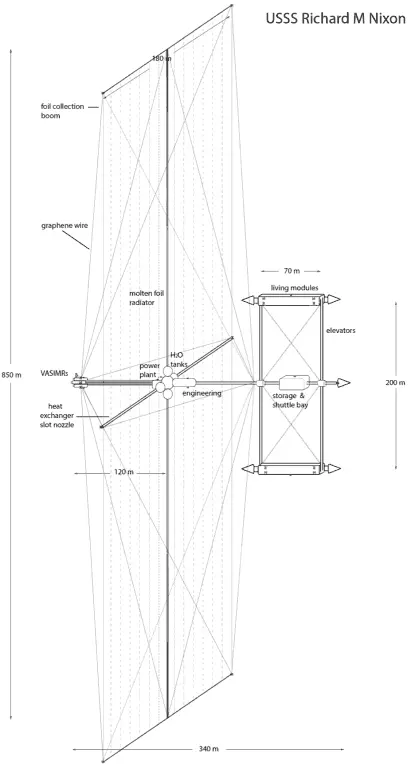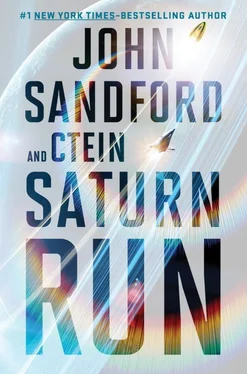“I’ll give it a try.”
“Thanks. I’d love to be able to tell you that nobody will hold it against you if you can’t pull it off, but we both know that’d be a lie. If we don’t beat China to Saturn, we’ll all be pilloried. The President will tank and she’ll make sure we’re all in the handbasket with her. Talk to you later.”
Vintner hung up.
Becca threw her coffee cup across the room where, unsatisfactorily, it bounced without shattering off a whiteboard and landed in a corner of the carpeted floor. Fuck it, she was done for the night. She shut down her workslate, pushed back her chair, and walked out of the office. Tomorrow was going to begin an unrelenting hell. Tonight she was going to study some margaritas.
Sandy had spent a week working on the vid for the first test of the Nixon ’s power plant. In fact, he’d worked right through New Year’s Eve, three days earlier. Fiorella, as it turned out, was a genius at explaining complicated technical matters in terms that anyone could understand, and occasionally even laugh at.
As with Becca Johansson’s solution for dissipating waste heat from the reactors…
Sandy launched his egg from the central axle and took it a kilometer out. In the past year, the metamorphosis of USSS3 station into the Richard M. Nixon had come a long way. He’d documented all of the major construction activities, the vid instantly relayed groundside. If anything went wrong, if there were any problems, analysis of the vid might give clues for possible fixes.
The Nixon was obviously a reworked USSS3. It still had three parallel tubes, side by side and spaced a hundred meters apart. The two outer tubes, each a hundred meters long, still contained the ship’s living quarters and were still known as Habitats 1 and 2. The center tube, the axle, contained storage and the shuttle bay.
The axle, instead of stopping where it intersected the rear connecting elevator tubes, continued back for another two hundred and seventy meters. About halfway back on the extended axle—all of it still zero-gee—were the engineering section and the twin reactors of the nuclear power plant. At the aft end, another hundred meters away from the reactors, the VASIMRs were still under construction. Between the reactors and the engineering system were a cluster of spherical tanks that would hold the thousands of tons of water that would make up the reaction mass for the VASIMRs.

And then there was Becca’s answer to the waste heat problem. In the nine weeks since the Chinese had launched, she’d moved heaven, Earth, and no small number of recalcitrant engineers. Between Engineering and the reactor modules, two four-hundred-meter-long masts projected out from the center axle, from Sandy’s viewpoint, one “up,” one “down.” At the end of each mast was what Sandy, who had done some sailing, thought of as a spar—but which also looked like the crossbar on a capital letter T.
Two more beams, the same length as the top spars on the T, projected out “horizontally” for a hundred meters on both sides of the axle. They held the extrusion nozzles for the molten radiator alloy that Becca Johansson would use to cool the reactors. The “T” spars would re-collect the now-frozen alloy, effectively thin sheets of foil, and send it back to the reactor.
Dozens of nearly invisible guy wires ran from the booms and masts to the axle. The guy wires were made of graphene composites that tied all the pieces into a rigid structure, far more inflexible and lightweight than any equivalent scaffold of metal. It reminded Sandy of an unfinished box kite, all balsa wood struts and string. At this moment, the struts were bare.
Shortly, there would be sails.
The engineers and design teams had fallen in line behind Becca Johansson’s scheme for handling the Nixon ’s prodigious power demands. Not because they were happy with it; they just couldn’t think of anything else that would let them beat the Chinese to Saturn.
Grumbling, they designed a ceramic core reactor that ran at a glowing-yellow temperature and heated the primary coolant—pressurized liquid sodium—to over nineteen hundred degrees Celsius. The superheated liquid sodium ran through a heat exchanger where it boiled more sodium. That vapor drove the primary ceramic composite turbines at two hundred atmospheres and nineteen hundred degrees Celsius.
The sodium vapor condensed downstream of the turbine, in a secondary heat exchanger, where it heated steam to a supercritical eight hundred and eighty degrees. That drove the next set of turbines. Extreme as all of this was, it didn’t justify an epithet like harebrained.
The final stage was another matter.
Downstream of the secondary turbines, the steam, cooled to six hundred and fifty degrees Celsius, entered the heat exchanger for the ship’s radiators. It melted radiator alloy, a eutectic blend of aluminum, magnesium, and beryllium that liquefied at six hundred degrees Celsius. In doing so, it absorbed nearly two hundred watt-hours of heat per kilogram of melt. All Becca had to do was get rid of the heat in the molten alloy, and that was what merited the epithet.
Her heat exchanger extruded the alloy into space in molten ribbons a meter wide and a tenth of a millimeter thick. Cold rollers in the extrusion nozzles clad the ribbons in a skin of frozen and roughened alloy, just microns thick.
The rough skin improved the ribbons’ heat radiation properties and kept the thin, wide bands of liquid alloy from breaking apart into a spray of droplets. As they sped toward the spars four hundred meters away, the ribbons cooled and froze, radiating tremendous amounts of energy into space.
It was a brutally efficient scheme for dumping the vast amounts of heat, but it was tricky.
The nearly liquid ribbons of metal had to be guided electromagnetically as they squirted out from both sides of an extrusion boom, and then led to the spars over four hundred meters out. There, the solidified ribbon was fed by rollers mounted on the spars to the central masts and back down into the melting pot. Managing one ribbon was a technically challenging feat. For Becca’s system to get the Nixon to Saturn, it had to extrude and control hundreds of them, all at the same time.
Thus, sails—or, for the more poetic, a moth with huge wings and a tiny body.
Each of the sails comprised almost a hundred ribbons, running side by side from the boom that extruded them to the spars, across the spars and back to the heat exchanger reservoir. The alloy circulated perpetually, hundreds of semi-molten ribbons in constant motion, safely disposing of the reactors’ waste heat. When the ship was under full power, 150,000 square meters of the dull silvery metal—the equivalent of twenty-eight American football fields—would radiate nine gigawatts of heat into space. So said the theory.
As for the practice, the first full-scale test would give them a good idea of what worked, and what might not.
The power engineers had to bring the reactors online to produce enough heat and power to test out the turbines and the boilers and melt the alloy reservoir of the heat exchanger. But they couldn’t go too far, too quickly, because the relatively puny auxiliary cooling system had to handle the thermal load until the main heat exchanger was fully operational. It was a delicate matter. Reactors of this design didn’t really like being run at less than one percent of their rated output. If an instability got out of hand it could result in a core meltdown, and that would be the end of the mission, and possibly the space station.
Читать дальше









